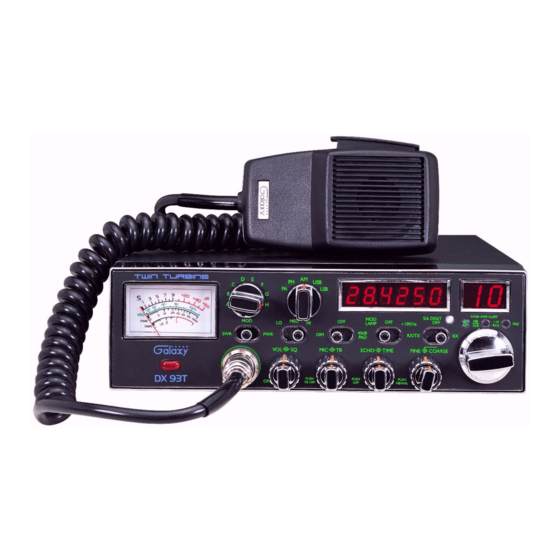Galaxy DX 93T 소유자 매뉴얼 - 페이지 6
{카테고리_이름} Galaxy DX 93T에 대한 소유자 매뉴얼을 온라인으로 검색하거나 PDF를 다운로드하세요. Galaxy DX 93T 11 페이지. 10 meter amateur mobile transceiver with built-in frequency counter & starlite face plate

RECEIVING SSB SIGNALS
There are four types of signals presently used for communications: FM, AM,
USB and LSB. When the MODE switch on your unit is placed in the AM
position, only standard double-side band and in FM position, only frequency
deviation, full carrier signals will be detected. An SSB signal may be recognized
while in the AM or FM mode by its characteristic "Donald Duck" sound and the
inability of the detector to produce an intelligible output. The USB and LSB
modes will detect upper sideband and lower sideband respectively, and standard
AM signals.
SSB reception differs from standard AM reception in that an SSB receiver does
not require a carrier or opposite side band to produce an intelligible signal. A
single-side band transmitted signal consists only of the upper or the lower side
band and no carrier is transmitted. The elimination of the carrier from the AM
signal helps to eliminate the biggest cause of whistles and tones heard on
channels that make even moderately strong AM signals unreadable. Also, SSB
takes only half the space of an AM channel, therefore two SSB conversations will
fit into each channel, expanding the 40 AM channels to 80 SSB channels. The
reduction in channel space required also helps in the receiver because only half of
the noise and interference can be received with 100% of the SSB signal.
An SSB signal may be received only when the listening receiver is functioning
in the same mode. In other words, an upper side band signal (USB) may be made
intelligible only if the receiver is functioning in the USB position.
If a lower side band (LSB) signal is heard when the receiver is in the USB
mode, no amount of tuning will make the signal intelligible. The reason for this
may be understood if you consider that when the modulation is applied to the
transmitter's microphone in the USB mode, the transmitter output frequency is
increased whereas in the LSB mode the transmitter's output frequency is
decreased.
The result in listening to the receiver is that when the MODE switch is in the
proper position (either USB or LSB), a true reproduction of a single tone of
modulation will result, and if the tone is increased in frequency (such as a low-
pitched whistle or a high-pitched whistle) you will hear the increase in the output
tone of the receiver. If the incorrect mode is selected, an increase in tone of a
whistle applied to the transmitter will cause a decrease in the resultant tone from
the receiver.
- 10 -
Thus when a voice is used in place of a whistle or tone, in the proper listening
mode the voice will be received correctly whereas in the incorrect mode, the
voice will be translated backwards and cannot be made intelligible by the
COARSE/FINE control. When listening to an AM transmission, a correct side
band is heard in either mode since both upper and lower side bands are received.
Once the desired SSB mode has been selected, frequency adjustment may be
necessary in order to make the incoming signal intelligible. The COARSE/FINE
control allows the operator to vary frequency above or below the exact frequency
of the channel. If the sound of the incoming signal is high or low pitched, adjust
the operation of the COARSE/FINE.
Consider it as performing the same function as a phonograph speed control.
When the speed is set too high, voices will be high-pitched and if set too low,
voice will be low-pitched. Also, there is only one correct speed that will make a
particular record produce the same sound that was recorded. If the record is
played on a turntable that is rotated in the wrong direction (opposite side band) no
amount of speed control (COARSE/FINE) will produce an intelligible sound.
An AM signal received while listening in one of the SSB modes will produce a
steady tone (carrier) in addition to the intelligence, unless the SSB receiver is
tuned to exactly the same frequency by the COARSE/FINE control. For
simplicity, it is recommended that the AM modes be used to listen to AM signals.
- 11 -
